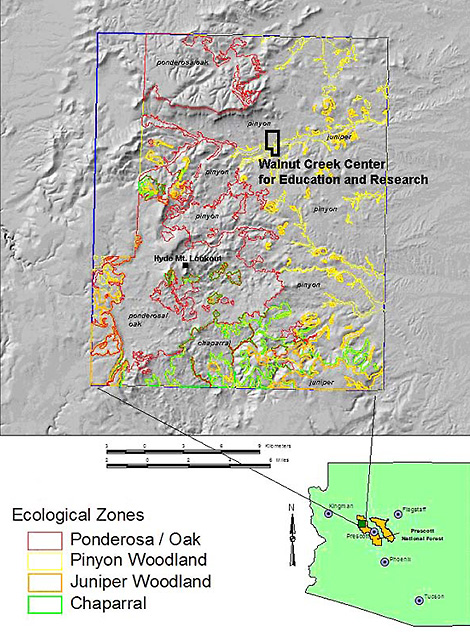Background
The Prescott National Forest established the Walnut Creek Station in 1908 to serve as the District Ranger Station for the northwest quadrant of the Prescott National Forest. Walnut Creek also served as a major center for fire suppression activities, working in concert with the nearby Hyde Mountain fire lookout. The station was used as a camp by the Civilian Conservation Corps (CCC) during the 1930’s. During this time, the CCC built the ranger’s residence (1934) and the multipurpose building (1936). The CCC also engaged in an effort to restrict Walnut Creek to a more defined channel. This was accomplished by riprapping stream banks and by removing a granitic dike in the Walnut Creek channel that had acted as a natural dam. In the 1970’s the station was expanded with the addition of a large septic system and leach field and a new area of trailer pads for housing firefighters. By 1995, the District Ranger office had been moved to the nearby community of Chino Valley and fire suppression logistics were moved to Prescott. By 1996, the station was essentially abandoned.
Discussions were initiated at that time among representatives from Prescott College, Sharlot Hall Museum, Yavapai College (all located in Prescott), Northern Arizona University (located in Flagstaff) and the Prescott National Forest about the possibility of developing an educational and research facility at the site. In 1998, the museum, colleges and university formed the Walnut Creek Center for Education and Research as a legal partnership. In 1999, WCCER entered into lease agreements for the Walnut Creek site with the Prescott National Forest. The lease that covers the primary facilities and grounds of the field station is a special use permit under the authority granted by the Granger-Thye Act of 1950. It is renewable on a 10-year basis.
Since that time, WCCER has been performing needed upgrades on the buildings at Walnut Creek, including abatement of lead paint, replacement of rotted exterior siding, and other critical infrastructure needs. During this same period, the facility has seen significant use from field courses and researchers. An on-site program manager has been in place continuously since 1999. In that year, fences were reconstructed to exclude cattle from neighboring ranches from the field station property.
WCCER location


